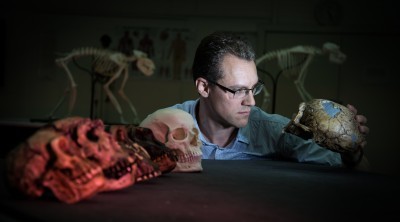By Ana Verayo, | February 27, 2016

Alistair Evans examines a range of hominin skull casts that were included in the study.
Fossilized teeth from prehistoric humans are often found isolated from other bones, which can also provide important clues about its source, as scientists now have a new technique that can help determine the tooth and jaw size of any incomplete fossil.
Like Us on Facebook
In this new study, scientists have identified a crucial pattern for mammals and humans that the size of the molar is the average of the size of the two molars beside it including the wisdom tooth. This default pattern is called the "inhibitory cascade" that can be applied to molars and premolars of modern humans and their predecessors.
New findings also determined the indistinct differences of the Homo genus that includes modern humans and Neanderthals, compared with the Australopith genus that also includes the famous Lucy fossil, which is an Australopithecus afarensis.
The team from the School of Biological Sciences at Monash University is led by Alistair Evans, who found this pattern after carefully analyzing hundreds of fossilized teeth originating from modern and ancient humans, including primates such as great apes, gorillas and chimpanzees.
Evans says that hominins especially all Australopiths have basically the same pattern when they possess five teeth in a row, revealing that they increase in size beginning from the first, second, third and fourth where the fifth teeth is the same size as the fourth tooth.
For Homo species, he adds, instead of the fourth tooth being the largest one, the third tooth ends up being the largest one which is the middle tooth in humans, where the first molar is the largest tooth in our teeth row.
In order to determine this, researchers carried out a series of measurements for size, and then scanning teeth using CT scans where they finally figured out that the most accurate formula is to multiply the width of the tooth with its length to form a rectangle that represents its crown size.
Evans says that this change in tooth size pattern among the Homo species and the Australopiths could be caused by differences in diet, as harder foods require more bite strength. He adds how biting hard can move food further back inside the mouth, which means that bite force could be larger at the back of the mouth.
Researchers revealed that the Australopiths' biggest teeth were located at the back of their jaw as Homo species' largest ones are closer to the middle jaw.
This new study could help in better of analysis of hominin fossil finds such as the recent discovery of the Homo naledi in South Africa which could provide more clues about the life of ancient humans and other early mammals.
Evans says that teeth that survived into the fossil record can tell what the animal was, providing detailed information about what they ate, and their daily activities in their environment and how they are related with others. This new study is published in the journal, Nature.
-
Use of Coronavirus Pandemic Drones Raises Privacy Concerns: Drones Spread Fear, Local Officials Say

-
Coronavirus Hampers The Delivery Of Lockheed Martin F-35 Stealth Fighters For 2020

-
Instagram Speeds Up Plans to Add Account Memorialization Feature Due to COVID-19 Deaths

-
NASA: Perseverance Plans to Bring 'Mars Rock' to Earth in 2031

-
600 Dead And 3,000 In The Hospital as Iranians Believed Drinking High-Concentrations of Alcohol Can Cure The Coronavirus

-
600 Dead And 3,000 In The Hospital as Iranians Believed Drinking High-Concentrations of Alcohol Can Cure The Coronavirus

-
COVID-19: Doctors, Nurses Use Virtual Reality to Learn New Skills in Treating Coronavirus Patients







